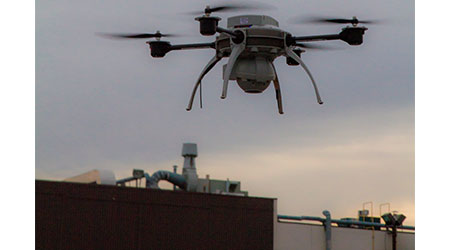« Facilities Technology Briefs Home /
Roofing
Unmanned Aerial Vehicle Provides Roof Inspection Opportunities - Tremco - Facility Management Product Release

Tremco
website
| Company information
The Federal Aviation Administration (FAA) granted approval for the first nighttime commercial drone operation in the U.S. to SkyBEAM unmanned aerial vehicles (UAVs) from Tremco Roofing & Building Maintenance. SkyBEAM is also approved to operate during the day.
The groundbreaking SkyBEAM (Building Envelope Asset Mapping) UAV flies around buildings and uses high-definition (HD) video and thermographic (infrared) cameras to locate where they may have energy leaks, rooftop damage, deteriorating façades, safety issues and other potential problems. SkyBEAM’s thermographic camera shows temperature variations around a building that indicate problems, such as poor or missing window sealing or wet rooftop insulation, that can lead to significant capital expenses, increased operating costs, occupant discomfort and other issues.
Infrared scanning is most effective at night, when the sun is not warming the building. Traditional infrared scans require technicians to traverse rooftops at night, while façade inspections dictate working from scaffolding or cranes. SkyBEAM is safer, faster, more cost effective and more accurate than conventional methods of mapping buildings. In addition to its infrared scanning capability, SkyBEAM has an exceptionally high resolution video camera that can easily read the fine print on a warranty from 50 feet. This camera can map potential building problems, such as gaps or tears in the roof, tiny cracks or movement in the façade, deteriorating concrete and the need for appropriate rooftop safety equipment.
“Using SkyBEAM to gather building data is the best solution overall,” says Tremco Roofing Vice President of Sales Paul Sheehy. “We program the UAV to fly to a precise height, do the mapping and return. We can now map buildings without the time and expense of using tools such as scaffolding. SkyBEAM enables us to find problems for our customers that would have been virtually impossible to detect before, and without risking people’s safety.”
Technicians can then safely mark problem areas during the day for removal and replacement, or further analysis if necessary. A highly trained two-person crew, including a licensed pilot, operates the UAV safely on the ground. SkyBEAM can fly horizontally across roofs, or vertically up to 400 feet (approximately 40 stories). It can reach speeds of 25 mph and retain its flight path in winds of up to 25 mph and gusts reaching 50 mph.
Toronto-based Industrial SkyWorks (ISW), a leader in aerial building inspections using unmanned technologies, developed SkyBEAM in partnership with Tremco Roofing. ISW has been operating Tremco Roofing SkyBEAM drones in Canada over the past 18 months to great success. The FAA has approved ISW to operate SkyBEAM commercially in the U.S; SkyBEAM is available to Tremco Roofing’s customers through our exclusive relationship with ISW.
SkyBEAM is ideal for low-slope roofing and façade diagnostics on multi-building campuses such as educational institutions and healthcare facilities. It is being supported by the 200-plus Tremco Roofing sales representatives across the country, as well as more than 600 field technicians in Tremco’s WTI (Weatherproofing Technologies Inc.) subsidiary. Façade inspection ordinances have become increasingly common as cities such as New York, Chicago and numerous others seek to ensure public safety.
“We are extremely pleased with the FAA’s support to help address this growing regulatory need,” said Sheehy. “SkyBEAM provides a dramatic leap forward, improving safety, efficiency and analysis. We look forward to working with the FAA, our industry partners and building owners to make further improvements to the façade inspection process.”
Interactive reporting clearly shows the building’s condition SkyBEAM’s software consolidates infrared scans and HD video images into a comprehensive, interactive, easy-to-understand report that facility owners and managers, and technicians access through a cloud-based application. The report clearly and accurately shows problem areas, helping decision makers determine their plan of action. A virtual model of the building is created in 2D and 3D and can be viewed from any angle. The model allows users to overlay thermal images to their exact location on the building. Photographs, comments and other data can be added in real time through a tablet, including when technicians are on site, to ensure that work can be verified and that the report always has the latest information.
Data can also be transmitted down to those on the roof. Through geo-positioning, technicians can always see their exact location in relation to problem areas. As they walk across the roof, the scan moves with them so they can precisely locate where work needs to take place. From the success that SkyBEAM has seen in Canada, Sheehy believes that it will revolutionize the industry. “There is nothing like SkyBEAM, and we’re delighted to bring its many benefits to our customers in the U.S.,” he said. “It gives decision makers visual evidence of where their building is losing energy, especially from areas that were difficult to scan before. SkyBEAM will help them improve their facility maintenance planning and budgeting, is the safest way to conduct nighttime infrared scanning, and is a huge benefit to our field technicians and contractors who need to locate and repair rooftop and facade damage.”
RELATED CONTENT
Content Category: Roofing
FEATURES:
QUICK READS:
posted: 9/8/2016








